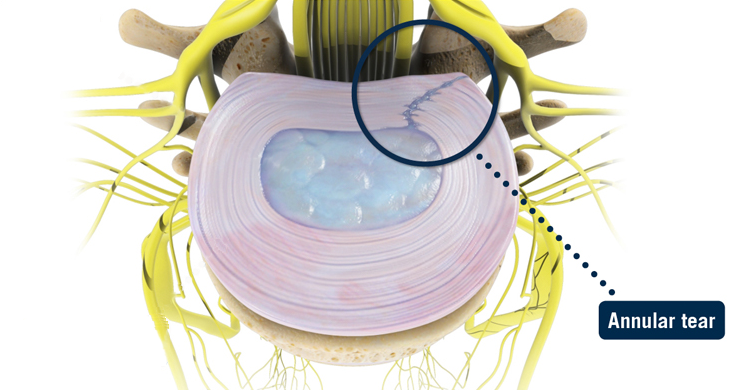Annular Tear
An annular tear is a fissure or crack on the annulus fibrosis, the thick outer layer of a vertebral disc. This condition can eventually lead to a herniated disc when the gel inside the disc starts to leak out through the disc wall. Although there are many causes for this condition, the most common one is the deterioration of the spine that naturally occurs with age.
As the spine ages, years of repetitive motion, playing sports, and even the pressure of increased body weight wear down the spine’s components. When a disc between the vertebrae is pressed on for a length of time, the outer lining of the disc can crack. This is an annular tear.
Anatomy
An intervertebral disc is a strong ligament that connects one vertebral bone to the next. Each disc acts as shock absorber for the vertebrae it separates. Each disc is composed of a strong ring of cartilage fibers, the annulus fibrosus, and a jelly-like center composed mostly of water, the nucleus pulposus.
The annulus connects each vertebra and is the strongest part of the disc. It contains the nucleus and distributes pressure evenly across the disc. The nucleus is composed mainly of water and serves as the main shock absorber, shielding your spine from the impact of your body’s daily activities and keeping your vertebrae separated.
At birth, 80% of the disc is composed of water, and it stays well hydrated to function properly. The nucleus pulposus carries the majority of the body’s axial load and relies on its water-based contents to maintain pliability and strength.
What is an Annular Tear
Just like any other ligament in your body, the discs can become injured. The annulus can rupture or tear anywhere on the disc. When a tear occurs, and no disc material is ruptured, it is called an annular tear.
An annular tear can be extremely painful because the outer third of the disc’s annular ring contains many nerve fibers. Although the tear may heal in time, it will be susceptible to future tears and injury. In addition, annular tears can lead to premature degenerative disc disease, facet joints, and end plates.
Annular Tear Causes
The annulus fibrosus is subject to several conditions that can cause an annular tear that can lead to nerve compression in the spinal column. Conditions that can cause deterioration of the cartilage and can lead to an annular tear include:
- Herniated disc
- Bulging disc
- Foraminal Stenosis
- Spinal stenosis
- Degenerative disc disease
- Osteoarthritis
Annular Tear Symptoms
The symptoms you feel due to an annular tear depend on the severity of the condition. For example, a mild tear might cause a twinge of pain in some sitting or bending positions, while a severely injured disc can cause many more severe symptoms. If you have an annular tear, you may experience one or more of the symptoms listed below.
- Chronic low back pain
- Chronic neck pain
- Sciatic pain
- Muscle weakness in the arms or legs
- Stiffness or soreness in the joints
- Numbness and tingling in the extremities
- A feeling of burning or heat along the sciatic nerve
Diagnosing an Annular Tear
Painful symptoms are usually the main reason patients seek treatment for a spine condition. Before your doctor can recommend treatment options, he or she must diagnose your condition. In order to diagnose an annular tear, your physician will test your strength and reflexes to determine the extent of your injury. He or she may request diagnostic tests such as an x-ray, MRI, or CT scan.
Annular Tear Treatment
Once you have been diagnosed with an annular tear, your physician may recommend a combination of conservative, non-surgical treatment options to relieve your pain and treat your symptoms. Conservative treatments do not treat the underlying condition directly, they reduce the painful symptoms so that your body can heal itself.
Non-Surgical Treatment
Conventional treatment options for an annular tear include:
- Physical therapy
- Over-the-counter or prescription pain medication
- Non-steroidal anti-inflammatory drugs (NSAIDs)
- Massage therapy to improve spinal alignment
- Stretching to relax the neck and back
- Chiropractic care
Surgical Treatment
While some patients find relief from pain with conservative, non-surgical treatments, many others find that their condition worsens with time and begins to affect their quality of life. If your condition has not improved or has worsened after several months of conservative treatment, your physician may suggest that you consult with a spine surgeon about a surgical intervention.
To find out if you are a candidate for the Bonati Spine Procedures, contact us today to have a patient advocate arrange a review of your MRI studies.
Prevention & Self-Care
Keeping your spine healthy and strong is the best way to prevent an annular tear, and lessening the symptoms if you do have one. Several lifestyle changes can impact your general health and offer great benefits for your spinal health. These changes may include:
- Quitting smoking
- Losing weight
- Exercising regularly
- Stretching
- Maintaining a good posture
- Reducing caffeine and alcohol consumption

